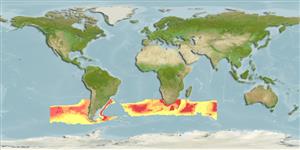Elasmobranchii (haaien en roggen) (sharks and rays) >
Squaliformes (Sleeper and dogfish sharks) >
Etmopteridae (Lantern sharks)
Etymology: Etmopterus: Greek, ethmos, -ou = sieve or ethmoides bone + Greek, pteron = wing, fin (Ref. 45335).
More on author: Günther.
Environment: milieu / climate zone / depth range / distribution range
Ecologie
marien; diepte 220 - 1620 m (Ref. 44037), usually 400 - 600 m (Ref. 124555). Deep-water; 29°S - 59°S
Indian Ocean, Southern Pacific and Southern Atlantic (Ref. 106604). Reported from off the western Cape coast but the identity of South African specimens is questionable (Ref. 127434).
Lengte bij maturiteit / Grootte / Gewicht / Leeftijd
Maturity: Lm ? range ? - 75 cm
Max length : 86.0 cm TL mannelijk / geslacht onbekend; (Ref. 122636); max. gepubliceerd gewicht: 3.6 kg (Ref. 122636)
Korte beschrijving
Determinatiesleutels | Morfologie | Morfometrie
Dorsale stekels (totaal) : 2; Anale stekels: 0. A large, heavy-bodied lanternshark with a big head (Ref. 5578), bladelike unicuspidate teeth in lower jaw and teeth with cusps and cusplets in upper jaw, stocky body, conspicuous lines of denticles on body, conspicuous black markings on underside of body and tail, with tail marking short and not extending far posteriorly (Ref. 247). Dark brown or black in color, possibly darker below (Ref. 26346).
Found on outermost continental shelves and upper slopes (Ref. 247). Feeds on bony fishes including lanternfish, barracudina, synaphobranchid eels, oreo dories, hake, rattails, bathylagids, idiacanthids; also on squids (including histioteuthids and ommastrephids), octopuses, euphausiids, mysids, penaeid shrimp, salps, sponges and ribbonworms (Nemertina) (Ref. 124555). Bioluminescence observed, with the dorsal photophores, flank markings, and brighter pectoral fin and claspers are likely to be used for intraspecific communications and the ventrally emitted light is likely to be used for counterillumination (Ref. 123656). Ovoviviparous (Ref. 205), with 10-13 in a litter, size at birth about 18 cm (Ref. 6871) to possibly 30 cm (Ref. 124555), Minimum depth reported taken from Ref. 247.
Ovoviviparous, with 10-13 in a litter (Ref. 6871). Size at birth about 18 cm (Ref. 6871). Distinct pairing with embrace (Ref. 205).
Compagno, L.J.V., 1984. FAO Species Catalogue. Vol. 4. Sharks of the world. An annotated and illustrated catalogue of shark species known to date. Part 1 - Hexanchiformes to Lamniformes. FAO Fish. Synop. 125(4/1):1-249. Rome, FAO. (Ref. 247)
Status op de Rode Lijst van het IUCN (Ref. 130435)
Gevaar voor de mens
Harmless
Gebruik door de mens
Visserij: van geen belang
Tools
Speciale rapporten
Download XML
Internetbronnen
Estimates based on models
Preferred temperature (Ref.
123201): 1.7 - 9.2, mean 3.2 °C (based on 174 cells).
Fylogenetische diversiteitsindex (Ref.
82804): PD
50 = 0.5000 [Uniqueness, from 0.5 = low to 2.0 = high].
Bayesian length-weight: a=0.00363 (0.00291 - 0.00454), b=3.08 (3.02 - 3.14), in cm total length, based on LWR estimates for this species (Ref.
93245).
Trofisch niveau (Ref.
69278): 4.2 ±0.2 se; based on diet studies.
Weerstandsvermogen (Ref.
120179): laag, minimale populatieverdubbelingstijd 4,5-14 jaar (Fec=10).
Fishing Vulnerability (Ref.
59153): Moderate to high vulnerability (54 of 100).
Climate Vulnerability (Ref.
125649): Low to moderate vulnerability (27 of 100).
Nutrients (Ref.
124155): Calcium = 7.13 [1.44, 36.37] mg/100g; Iron = 0.343 [0.085, 1.239] mg/100g; Protein = 19.4 [16.8, 21.5] %; Omega3 = 0.328 [0.118, 1.004] g/100g; Selenium = 12.4 [3.4, 39.9] μg/100g; VitaminA = 20.1 [4.0, 113.6] μg/100g; Zinc = 0.385 [0.186, 0.758] mg/100g (wet weight);
